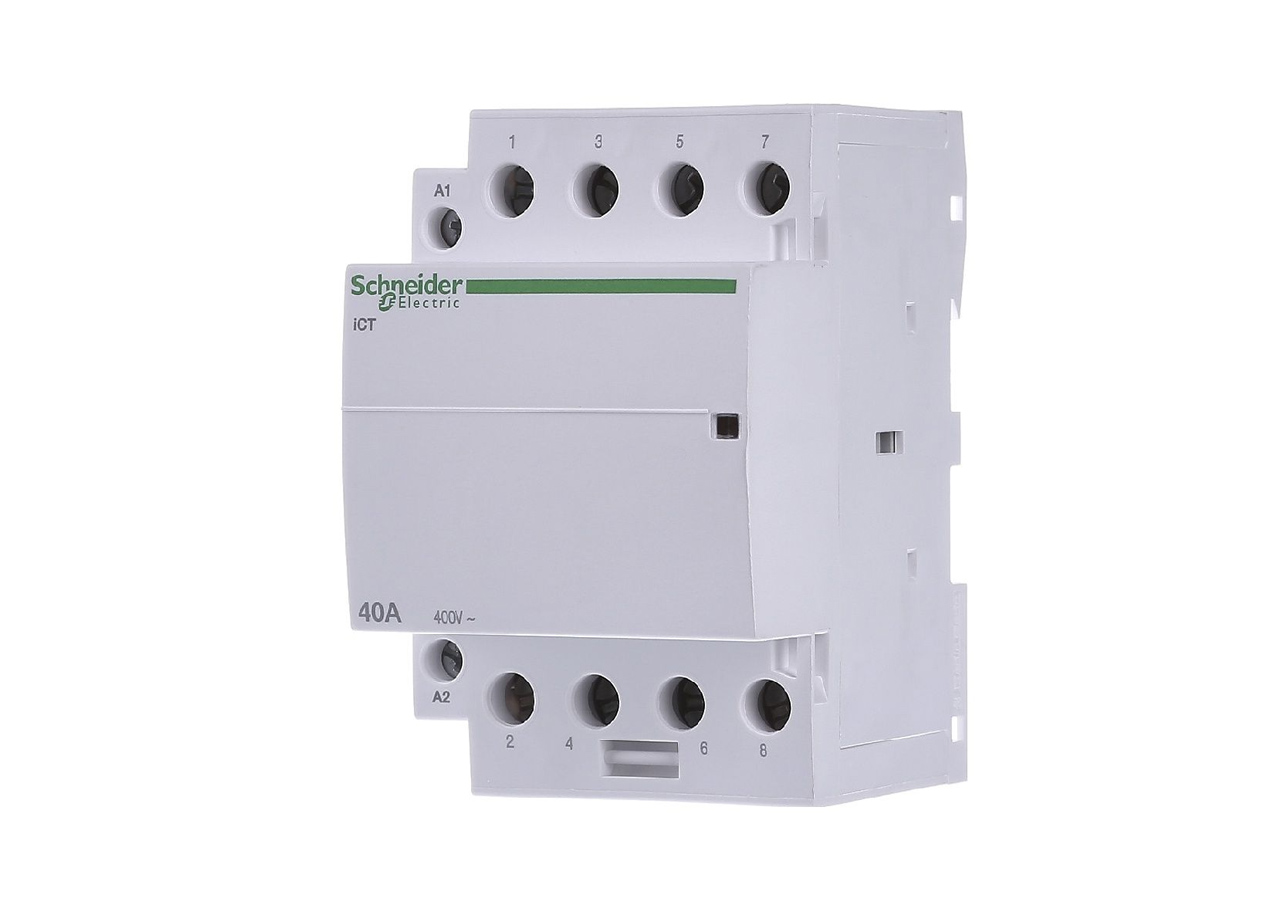Do you want to know why an installation contactor hums? Find out here. Or would you like to activate and stop large consumers using a remote switch? Then you need a high-quality and inexpensive installation contactor from the eibabo® technology store. With us you will find a large selection of high-quality installation contactors from many well-known brands. We carry installation contactors (REG) and accessories from the following manufacturers: Schneider Electric, Eberle Controls, Siemens, Eltako, ABB Stotz S&J,Finder, Eaton (Moeller) and Legrand (BT).
All offered installation contactors are characterized by:
- excellent processing quality
- little to no hum during operation
- quiet switching operations
- very good industrial quality
- high switching capacity
- long lifetime
What is an installation contactor in electrical engineering?
An installation contactor is an electrical device that is primarily used to protect electrical systems and devices from overload and short circuits. Installation contactors are mainly used in building installation for automation. In many cases, this involves the automatic switching on and off of electrical devices and systems. The installation contactor assumes the task of a remote switch, which switches a larger current with a lower current. In the area of electrical distribution installation and control panel installation, installation contactors are used, among other things, as series installation devices (REG) for mounting on DIN rails or support rails (35 mm) according to DIN EN 50022.
What are the typical areas of application of an installation contactor?
An installation contactor can be used, for example, to switch heating systems on and off automatically to protect them from overheating. Other automation processes include switching and controlling three-phase motors, lighting systems, ventilation, pumps, cable pulls, gates, shading systems and other building automation drives.
How does an installation contactor work?
Installation contactors usually work with operating voltages of 230V or 440V and with actuating voltages of 230V or 24V. There are also versions where both voltages are 230V. In addition to the housing, an installation contactor consists of an excitation coil, coil core, metal armature, switching contacts and armature return spring. There can be multiple of these essential functional elements in the installation contactor. The device consists of a control circuit and a load circuit. If current flows through the control circuit, the load circuit closes and also carries current. In the idle state (OFF), the switching contacts do not touch.
TIP:
If a contactor hums, this is not yet a cause for concern. This is due to dust and dirt or the rivets in the coil core loosening over time. Incipient wear on the short-circuit ring can also be a reason.
The task of the excitation coil is to generate a strong magnetic field when current flows. The coil core serves as a carrier for the coil and strengthens its magnetic field. This is the only way to overcome the force of the return spring. The magnetic effect becomes large enough to move the armature. As soon as the armature is attracted, the switch contacts touch and the contactor is active (ON). The return spring returns the armature to its original position when the coil's magnetic field disappears. The contacts loosen and the device goes back to sleep mode. This means that the device only stops by itself in the OFF position. The control circuit of the coil and the load circuit of the switch contacts are isolated from each other. The armature creates the connection between the circuits and enables the consumers to be switched on the load circuit. A contactor is therefore an electromechanical switch designed for high power, which is similar to a relay in terms of its function.
Can several contactors be combined?
You can combine multiple contactors to meet specific installation and automation needs. You have even more diverse control options if you use contactor relays to control the installation contactor or to display an operating status. Contactors of various combinations with a maximum of four contacts are often used (e.g. two NO contacts / two NC contacts or three NO contacts / one NC contact).
Contacts in an installation contactor
An installation contactor is usually provided with different types of contacts. A distinction is made between main contacts and auxiliary contacts.
Good to know
The contacts of a contactor are divided into working contact (closer), break contact (opener) and changeover contact (changeover contact). The changeover contact is a combination of opener and closer. Opener and closer can also be combined in one installation contactor.
The main contacts described in the function are used for the power to be switched. This makes it possible to connect large consumers. The auxiliary contacts are designed as signaling lines for contactor control and signal display.
What is an auxiliary contactor?
You have a wide range of control options when using contactor relays. Power contactors have a significantly higher switching capacity than contactor relays and switch load circuits of large consumers. Auxiliary contactors switch control voltages for small loads and are designed for small consumers and displays. You can use it to implement logical operations and control power contactors.
 Image: Schneider Electric A9C20844 installation contactor
Image: Schneider Electric A9C20844 installation contactor
What is the difference between a contactor and a relay?
Relays serve primarily as circuit breakers and control switches in devices and are important components in many control processes. There are different types of relays that perform different functions. The most common types include protection relays, monitoring relays, auxiliary relays and reclosing relays. Relays open and close circuits or contacts by responding to electrical quantities such as current or voltage. A contactor is an electromechanically controlled circuit switch. Here a circuit with a low power level is switching a circuit with a higher power level. A contactor is designed for operation with normally open contacts. If there is no power on the device, there is no switching connection. Relays can usually open and close. Another difference lies in the performance of the respective device. Contactors are used in control circuits with higher electrical voltages and higher currents. This results in further safety-relevant differences. Contactors work with tie rods and return springs, relays with hinged armatures or rotary armatures. Sparking caused by the separation of live contacts is reduced in the contactor with arc suppression. As a rule, relays switch much faster than contactors, are lighter, smaller and consume less energy. Due to the more complex structure, contactors are more expensive than relays.
![]()
Catalogue content:
In this eibabo® catalogue Devices for distribution board- / surface mounting > Installation contactor for distribution board you will find items from the following product groups:
Item overview:
- AC contactor
- Built-in contactor
- Built-in distributor device
- Changeover contactor
- Contactor module
- Control contactor
- DC contactor
- Heater contactor
- High power contactor
- Installation contactor
- Installation contactors
- Installation relay
- Lighting contactor
- Load contactor
- Magnetic switch
- Modular installation device
- Power contactor
- Series built-in contactor
- Small contactor
- Universal voltage contactor
from the following manufacturers:
Manufacturer overview catalogue Installation contactor mdrc:
- ABB
- Doepke
- Eaton
- Eberle
- Eltako
- Finder
- Hager
- Legrand Bticino
- Schneider Electric
- Siemens













